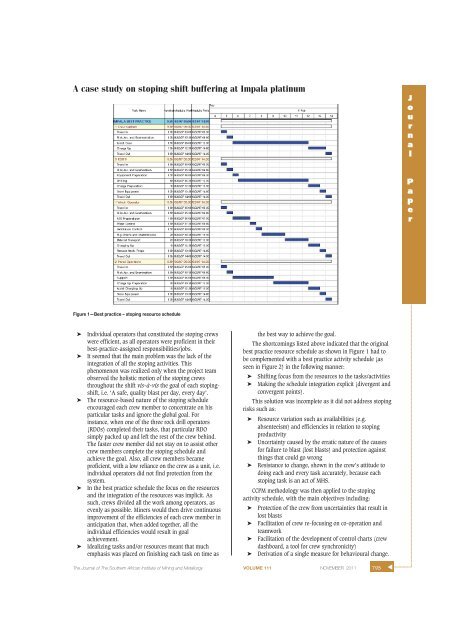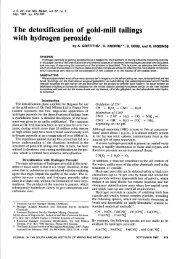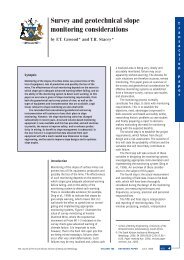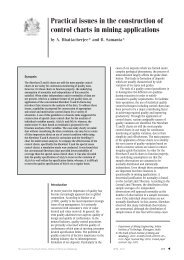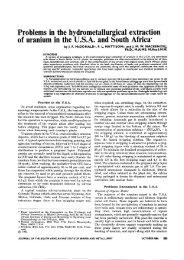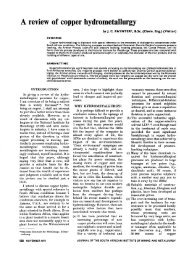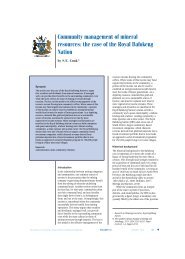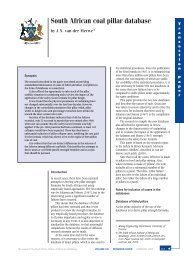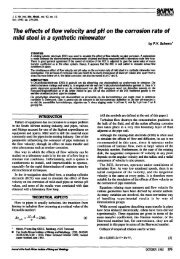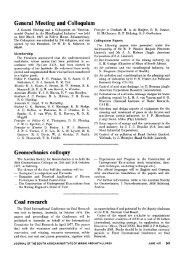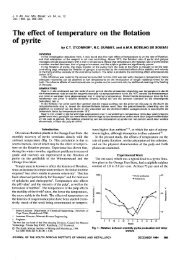Investigation of factors influencing the determination of ... - saimm
Investigation of factors influencing the determination of ... - saimm
Investigation of factors influencing the determination of ... - saimm
You also want an ePaper? Increase the reach of your titles
YUMPU automatically turns print PDFs into web optimized ePapers that Google loves.
A case study on stoping shift buffering at Impala platinum<br />
J<br />
o<br />
u<br />
r<br />
n<br />
a<br />
l<br />
P<br />
a<br />
p<br />
e<br />
r<br />
Figure 1—Best practice – stoping resource schedule<br />
➤<br />
➤<br />
➤<br />
➤<br />
➤<br />
Individual operators that constituted <strong>the</strong> stoping crews<br />
were efficient, as all operators were pr<strong>of</strong>icient in <strong>the</strong>ir<br />
best-practice-assigned responsibilities/jobs.<br />
It seemed that <strong>the</strong> main problem was <strong>the</strong> lack <strong>of</strong> <strong>the</strong><br />
integration <strong>of</strong> all <strong>the</strong> stoping activities. This<br />
phenomenon was realized only when <strong>the</strong> project team<br />
observed <strong>the</strong> holistic motion <strong>of</strong> <strong>the</strong> stoping crews<br />
throughout <strong>the</strong> shift vis-à-vis <strong>the</strong> goal <strong>of</strong> each stopingshift,<br />
i.e. ‘A safe, quality blast per day, every day’.<br />
The resource-based nature <strong>of</strong> <strong>the</strong> stoping schedule<br />
encouraged each crew member to concentrate on his<br />
particular tasks and ignore <strong>the</strong> global goal. For<br />
instance, when one <strong>of</strong> <strong>the</strong> three rock drill operators<br />
(RDOs) completed <strong>the</strong>ir tasks, that particular RDO<br />
simply packed up and left <strong>the</strong> rest <strong>of</strong> <strong>the</strong> crew behind.<br />
The faster crew member did not stay on to assist o<strong>the</strong>r<br />
crew members complete <strong>the</strong> stoping schedule and<br />
achieve <strong>the</strong> goal. Also, all crew members became<br />
pr<strong>of</strong>icient, with a low reliance on <strong>the</strong> crew as a unit, i.e.<br />
individual operators did not find protection from <strong>the</strong><br />
system.<br />
In <strong>the</strong> best practice schedule <strong>the</strong> focus on <strong>the</strong> resources<br />
and <strong>the</strong> integration <strong>of</strong> <strong>the</strong> resources was implicit. As<br />
such, crews divided all <strong>the</strong> work among operators, as<br />
evenly as possible. Miners would <strong>the</strong>n drive continuous<br />
improvement <strong>of</strong> <strong>the</strong> efficiencies <strong>of</strong> each crew member in<br />
anticipation that, when added toge<strong>the</strong>r, all <strong>the</strong><br />
individual efficiencies would result in goal<br />
achievement.<br />
Idealizing tasks and/or resources meant that much<br />
emphasis was placed on finishing each task on time as<br />
<strong>the</strong> best way to achieve <strong>the</strong> goal.<br />
The shortcomings listed above indicated that <strong>the</strong> original<br />
best practice resource schedule as shown in Figure 1 had to<br />
be complemented with a best practice activity schedule (as<br />
seen in Figure 2) in <strong>the</strong> following manner:<br />
➤ Shifting focus from <strong>the</strong> resources to <strong>the</strong> tasks/activities<br />
➤ Making <strong>the</strong> schedule integration explicit (divergent and<br />
convergent points).<br />
This solution was incomplete as it did not address stoping<br />
risks such as:<br />
➤ Resource variation such as availabilities (e.g.<br />
absenteeism) and efficiencies in relation to stoping<br />
productivity<br />
➤ Uncertainty caused by <strong>the</strong> erratic nature <strong>of</strong> <strong>the</strong> causes<br />
for failure to blast (lost blasts) and protection against<br />
things that could go wrong<br />
➤ Resistance to change, shown in <strong>the</strong> crew’s attitude to<br />
doing each and every task accurately, because each<br />
stoping task is an act <strong>of</strong> MHS.<br />
CCPM methodology was <strong>the</strong>n applied to <strong>the</strong> stoping<br />
activity schedule, with <strong>the</strong> main objectives including:<br />
➤ Protection <strong>of</strong> <strong>the</strong> crew from uncertainties that result in<br />
lost blasts<br />
➤ Facilitation <strong>of</strong> crew re-focusing on co-operation and<br />
teamwork<br />
➤ Facilitation <strong>of</strong> <strong>the</strong> development <strong>of</strong> control charts (crew<br />
dashboard, a tool for crew synchronicity)<br />
➤ Derivation <strong>of</strong> a single measure for behavioural change.<br />
The Journal <strong>of</strong> The Sou<strong>the</strong>rn African Institute <strong>of</strong> Mining and Metallurgy VOLUME 111 NOVEMBER 2011<br />
795<br />
▲


